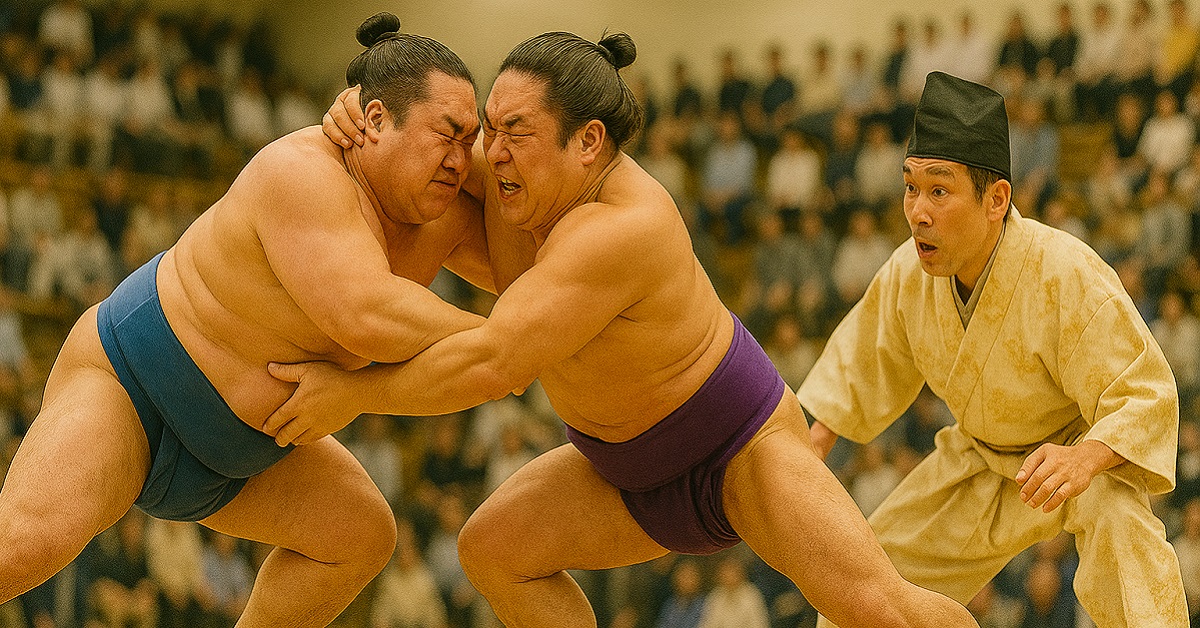In the world of sumo wrestling, few moments carry the intensity, symbolism, and tradition of the tachi-ai. As two rikishi lock eyes and synchronize their breathing, the arena falls silent. The sudden clash that follows is not just a start—it’s a declaration of spirit, skill, and mutual respect. For foreign spectators, understanding tachi-ai is key to appreciating the depth and beauty of Japanese sumo.
What Is Tachi-ai?
Tachi-ai is the act of rising simultaneously from a crouch and forcefully engaging with your opponent, signaling the official start of a sumo match. It is much more than a signal; it is a moment of intensity that can determine the outcome of the bout.
With their eyes locked and breathing synchronized, wrestlers unleash their intent and power in a single instant. Below is a table summarizing the key points of tachi-ai:
| Element | Description |
|---|---|
| Posture | Wrestlers crouch and compose themselves before moving |
| Signal | While the referee calls out, it’s the mutual gaze that determines timing |
| Timing | Not perfect simultaneity, but a shared rhythm and spirit are required |
| Caution | Premature movement (false starts) leads to a do-over; deceptive moves may be frowned upon |
| Purpose | To start the match fairly and with dignity |
The moment of tachi-ai captures the wrestlers’ commitment, strategy, and spirit.
Historical and Cultural Background of Tachi-ai
Tachi-ai dates back to the ancient times when sumo was performed as a Shinto ritual. Originally, sumo was offered to the gods to pray for good harvests, and bouts were seen as acts of devotion and strength. Today, the religious and cultural elements remain central in sumo, and tachi-ai reflects this.
For example, sprinkling salt before a bout purifies the ring and the body, while the crouching pose is a gesture of respect toward one’s opponent. The Japanese concepts of “ma” (timing/space) and quiet focus are reflected in the moments before tachi-ai.
| Ritual | Meaning |
|---|---|
| Sonkyo (crouch) | A gesture of mental and physical readiness |
| Sprinkling salt | Purifying the space and body, making the match sacred |
| Hands on the dohyo | Shows respect and intention for a fair fight |
| “Matta” (redo) | A chance to refocus and restore proper form before retrying |
Tachi-ai is an act that represents not only technique but also deep cultural and spiritual significance.
Rules and Prohibited Acts in Tachi-ai
Rules for tachi-ai ensure fair competition and order. Wrestlers must start simultaneously, and if one moves too early, the bout is restarted with a call of “matta.” Repeated false starts may lead to warnings or disapproval from referees.
While moves like sidestepping (henka) are technically legal, overuse or misuse can be considered disrespectful or unsportsmanlike. The following table outlines essential rules:
| Rule or Manners | Description |
|---|---|
| Synchronization | Wrestlers must align their intent and breathing before movement |
| False starts | Early movement leads to a restart, and repetition may result in warnings |
| Hands on ring | Wrestlers must touch the ring with both hands before engaging |
| Prohibited conduct | Taunting or delaying tactics are considered poor manners |
Tachi-ai is not just about starting the match—it is also a test of a wrestler’s character and discipline.
Techniques and Mind Games in Tachi-ai
Tachi-ai involves intense strategic thinking and psychological warfare. Wrestlers study their opponents’ habits and history to execute the most effective technique at the right moment. The strategies vary by wrestler and reflect their style.
| Tactic Type | Features |
|---|---|
| Charge-in | Relies on speed and power to dominate quickly |
| Slap | Aims at the face to unbalance the opponent |
| Sidestep (Henka) | Dodges the charge to exploit the opponent’s momentum |
| Body slam | Uses low stance and weight to apply pressure and overwhelm |
These techniques embody the intellect and physical skill required to succeed in sumo.
Viewing Tips: How to Enjoy Tachi-ai
For foreign visitors and beginners, understanding tachi-ai enhances the enjoyment of sumo. By observing the build-up—the posture, breathing, and mutual gaze—you can better appreciate the sport’s depth.
Watch how wrestlers stare each other down, adjust their stance, and breathe in sync. Even a “matta” offers a chance to witness the wrestler’s ability to refocus.
| Focus Point | Details |
|---|---|
| Stance depth | A low stance signals readiness to absorb or counter a charge |
| Eye contact | Silent communication of resolve and strategy |
| Breathing rhythm | Synchronicity signals the right moment to launch the match |
| Audience reaction | The hush or cheer of the crowd reflects the tension and excitement |
Tachi-ai is the moment when spectators can witness the very soul of sumo.
Conclusion
Tachi-ai is far more than the start of a sumo match. It is the embodiment of spirit, respect, tradition, and strategy. With roots in ancient rituals and a foundation in Japanese values, tachi-ai is a unique and essential aspect of sumo wrestling.
| Summary Element | Description |
|---|---|
| Meaning and Role | A crucial moment where strategy, spirit, and skill converge |
| Historical and Cultural | Rooted in Shinto rituals and Japanese traditional values |
| Discipline and Respect | Rules and manners maintain fairness and beauty |
| Technique and Tactics | Reflects each wrestler’s approach, strength, and mind game |
| How to Watch | Focus on subtle cues such as stance, breath, and gaze for deeper appreciation |
By understanding tachi-ai, you can unlock a deeper appreciation of sumo. For foreign spectators, it offers a powerful glimpse into the heart of Japanese culture and philosophy. The next time you watch sumo, take a moment to focus on tachi-ai—and let it speak to you through its silence, intensity, and elegance.





コメント